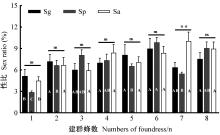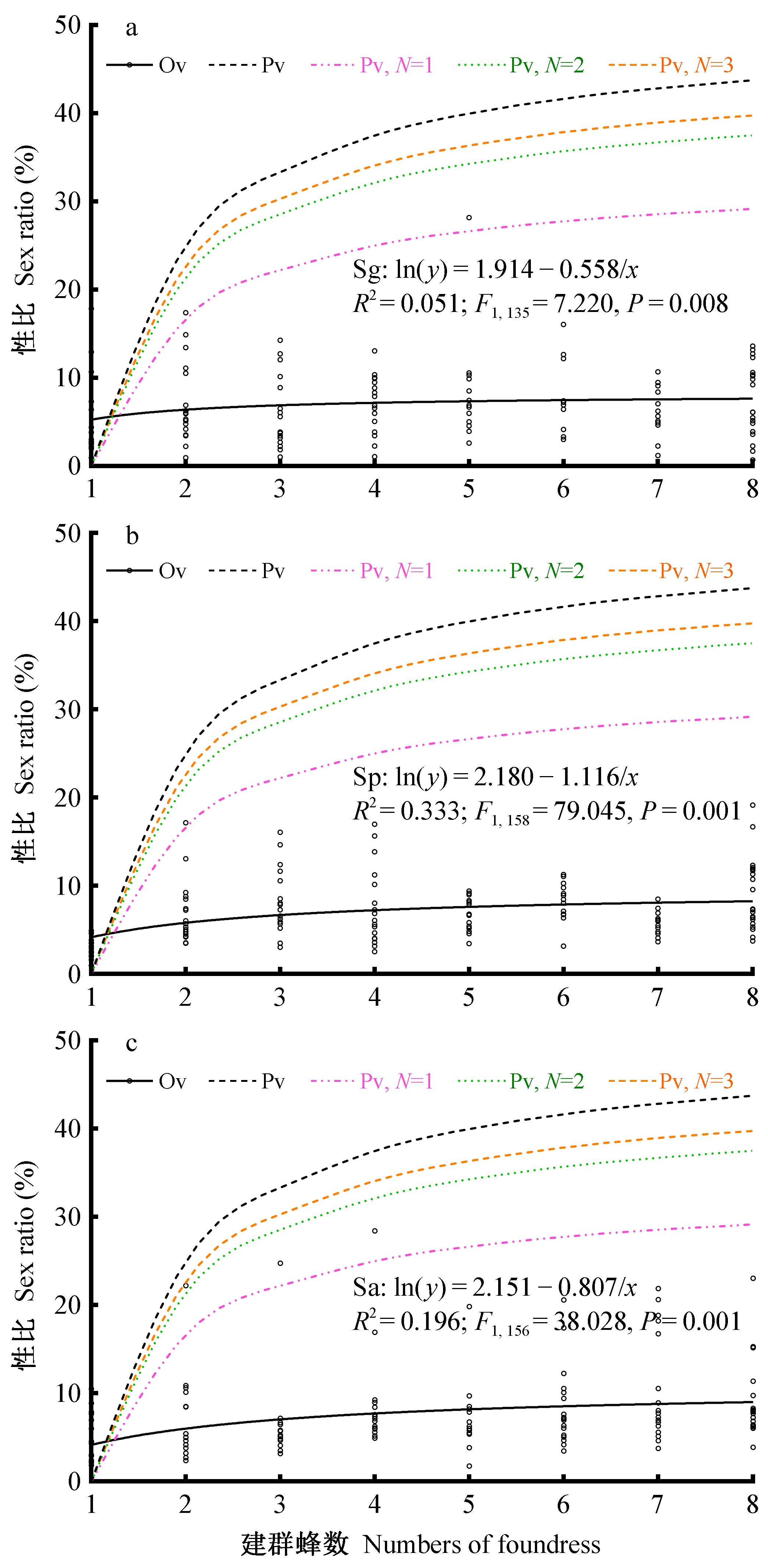

Scientia Silvae Sinicae ›› 2022, Vol. 58 ›› Issue (6): 161-168.doi: 10.11707/j.1001-7488.20220616
Yanlong Tang1,Lina Wang1,Yanqin Wang1,Yanlong Zhang2,Xiaoyi Wang2,Ke Wei2,*
Received:2021-03-22
Online:2022-06-25
Published:2022-09-24
Contact:
Ke Wei
CLC Number:
Yanlong Tang,Lina Wang,Yanqin Wang,Yanlong Zhang,Xiaoyi Wang,Ke Wei. Effects of Different Foundress Densities on Sex Ratio of the Offspring of Bethylid Wasps[J]. Scientia Silvae Sinicae, 2022, 58(6): 161-168.

Fig.1
Sex ratio of the bethylid wasps under different foundress densities Different letters in the same colored bars show significant difference of sex ratios among different foundress densities in a bethylid wasp, while the 'ns' and '**' above the bars mean no significance and significant difference of sex ratios of three bethylid wasps under the same foundress density at α = 0.01, respectively; Error bars are presented as SEM. The same below."


Fig.4
Measured and LMC predicated sex ratios of bethylid wasps under different foundress densities Pv: Predicted sex ratio based on LMC model, the black dot line indicates the values without inbreeding (model Ⅰ) and the colored dot lines indicate the vaules with inbreeding along with N=1, 2, 3 (model Ⅱ); Ov: Observed values of offspring sex ratio, the black circles and full lines indicate the measured sex ratios and regressions on foundress number."

| 陈然, 唐艳龙, 唐桦, 等. 麻竖毛天牛幼虫大小对松褐天牛肿腿蜂产卵决策的影响. 中国生物防治学报, 2019, 35 (6): 848- 854. | |
| Chen R , Tang Y L , Tang H , et al. Effects of larvae body size of Thyestilla gebleri on oviposition decision of Sclerodermus alternatusi. Chinese Journal of Biological Control, 2019, 35 (6): 848- 854. | |
| 唐艳龙, 王丽娜, 张彦龙, 等. 不同建群蜂数对松褐天牛肿腿蜂繁育效果的影响. 林业科学, 2020a, 56 (9): 97- 103. | |
| Tang Y L , Wang L N , Zhang Y L , et al. Effect of different parasitoid colonies on the mass rearing of Sclerodermus alternatusi (Hymenoptera: Bethylidae). Scientia Silvae Sinicae, 2020a, 56 (9): 97- 103. | |
| 唐艳龙, 王丽娜, 吴胜勇, 等. 松褐天牛肿腿蜂的产卵模式: 雄性先产的有利原则. 中国生物防治学报, 2020b, 36 (5): 832- 836. | |
| Tang Y L , Wang L N , Wu S Y , et al. Oviposition pattern of Sclerodermus alternatusi: benefits of laying unfertilized eggs first. Chinese Journal of Biological Control, 2020b, 36 (5): 832- 836. | |
| 王子龙, 潘露霞, 胡弯弯, 等. 膜翅目昆虫的性别决定机制. 昆虫学报, 2019, 62 (11): 1335- 1343. | |
| Wang Z L , Pan L X , Hu W W , et al. Mechanisms of sex determination in hymenopteran insects. Acta Entomologica Sinica, 2019, 62 (11): 1335- 1343. | |
| 伍绍龙, 徐福元, 李保平, 等. 管氏肿腿蜂雌性抚育中幼虫转移行为的启动和节律. 昆虫学报, 2013, 56 (4): 392- 397. | |
| Wu S L , Xu F Y , Li B P , et al. Initiation and rhythm of larva-translocation behavior during maternal care in an ectoparasitoid Sclerodermus guani (Hymenoptera: Bethylidae). Acta Entomologica Sinica, 2013, 56 (4): 392- 397. | |
| 杨忠岐, 王小艺, 曹亮明, 等. 管氏肿腿蜂的再描述及中国硬皮肿腿蜂属Sclerodermus (Hymenoptera: Bethylidae) 的种类. 中国生物防治学报, 2014, 30 (1): 1- 12. | |
| Yang Z Q , Wang X Y , Cao L M , et al. Re-description of Sclerodermus guani and revision of the genus (Hymenoptera: Bethylidae) in China. Chinese Journal of Biological Control, 2014, 30 (1): 1- 12. | |
|
Abdi M K , Lupi D , Hardy I C W . Co-foundress confinement elicits kinship effects in a naturally sub-social parasitoid. Journal of Evolutionary Biology, 2020, 33 (8): 1068- 1085.
doi: 10.1111/jeb.13635 |
|
|
Alexander R D , Sherman P W . Local mate competition and parental investment in social insects. Science, 1977, 196 (4289): 494- 500.
doi: 10.1126/science.196.4289.494 |
|
|
Beye M , Hasselmann M , Fondrk M K , et al. The gene csd is the primary signal for sexual development in the honeybee and encodes an SR-type protein. Cell, 2003, 114 (4): 419- 429.
doi: 10.1016/S0092-8674(03)00606-8 |
|
|
Boulton R A , Collins L A , Shuker D M . Beyond sex allocation: the role of mating systems in sexual selection in parasitoid wasps. Biological Reviews, 2015, 90 (2): 599- 627.
doi: 10.1111/brv.12126 |
|
|
Boulton R A , Cook N , Greenway E V , et al. Local mate competition modifies the costs of mating in a mostly monandrous parasitoid wasp. Behavioral Ecology, 2019, 30 (2): 417- 425.
doi: 10.1093/beheco/ary181 |
|
|
Burton-Chellew M N , Koevoets T , Grillenberger B K , et al. Facultative sex ratio adjustment in natural populations of wasps: cues of local mate competition and the precision of adaptation. The American Naturalist, 2008, 172 (3): 393- 404.
doi: 10.1086/589895 |
|
|
Chung N , Pienaar J , Greeff J M . Evolutionary stable sex ratios with non-facultative male-eggs first sex allocation in fig wasps. Oikos, 2019, 128 (6): 859- 868.
doi: 10.1111/oik.06068 |
|
|
Cole L R . A visible sign of a fertilization action during oviposition by an ichneumonid wasp, Itoplectis maculator. Animal Behaviour, 1981, 29 (1): 299- 300.
doi: 10.1016/S0003-3472(81)80178-9 |
|
| Fisher R A . The genetical theory of natural selection. London: Clarendon Press, 1930. | |
|
Greeff J M , Pentz K , Warren M . The efficacy of natural selection in producing optimal sex ratio adjustments in a fig wasp species. Proceedings of The Royal Society B: Biological Sciences, 2020, 287 (1934): 20201377.
doi: 10.1098/rspb.2020.1377 |
|
|
Hall A B , Basu S , Jiang X F , et al. A male-determining factor in the mosquito Aedes aegypti. Science, 2015, 348 (6240): 1268- 1270.
doi: 10.1126/science.aaa2850 |
|
|
Hamilton W D . Extraordinary sex ratios. Science, 1967, 156 (3774): 477- 488.
doi: 10.1126/science.156.3774.477 |
|
| Hamilton W D. 1979. Wingless and fighting males in fig wasps and other insects//Blum M S, Blum N A. Reproductive competition, mate choice and sexual selection in insects. New York: Academic Press, 167-220. | |
|
Harvey J A , Strand M R . The developmental strategies of endoparasitoid wasps vary with host feeding ecology. Ecology, 2002, 83 (9): 2439- 2451.
doi: 10.1890/0012-9658(2002)083[2439:TDSOEW]2.0.CO;2 |
|
|
Hasselmann M , Gempe T , Schiøtt M , et al. Evidence for the evolutionary nascence of a novel sex determination pathway in honeybees. Nature, 2008, 454 (7203): 519- 522.
doi: 10.1038/nature07052 |
|
|
Heimpel G E , de Boer J G . Sex determination in the Hymenoptera. Annual Review of Entomology, 2008, 53, 209- 230.
doi: 10.1146/annurev.ento.53.103106.093441 |
|
|
Heimpel G E , Lundgren J G . Sex ratios of commercially reared biological control agents. Biological Control, 2000, 19 (1): 77- 93.
doi: 10.1006/bcon |
|
|
Irvin N A , Hoddle M S . The effect of intraspecific competition on progeny sex ratio in Gonatocerus spp. for Homalodisca coagulata egg masses: economic implications for mass rearing and biological control. Biological Control, 2006, 39 (2): 162- 170.
doi: 10.1016/j.biocontrol.2006.05.005 |
|
|
Kapranas A , Hardy I C W , Tang X Y , et al. Sex ratios, virginity, and local resource enhancement in a quasisocial parasitoid. Entomologia Experimentalis et Applicata, 2016, 159 (2): 243- 251.
doi: 10.1111/eea.12418 |
|
|
Khidr S K , Mayes S , Hardy IC W . Primary and secondary sex ratios in a gregarious parasitoid with local mate competition. Behavior Ecology, 2013, 24 (2): 435- 443.
doi: 10.1093/beheco/ars181 |
|
|
King B H . Offspring sex ratios in parasitoid wasps. Quarterly Review of Biology, 1987, 62 (4): 367- 396.
doi: 10.1086/415618 |
|
| Li Q , Xie L , Chen W , et al. Sex ratio shifts of the solitary parasitoid wasp, Pachycrepoideus vindemmiae (Hymenoptera: Pteromalidae), to other foundresses. Evolutionary Ecology Research, 2014, 16 (7): 605- 616. | |
|
Martel V , Doyon J , Boivin G . Partial local mate competition in the wasp Trichogramma euproctidis: the role of emergence sex ratio on female mating behaviour. Ecological Entomology, 2010, 35 (6): 698- 703.
doi: 10.1111/j.1365-2311.2010.01229.x |
|
|
Meccariello A , Salvemini M , Primo P , et al. Maleness-on-the-Y (MoY) orchestrates male sex determination in major agricultural fruit fly pests. Science, 2019, 365 (6460): 1457- 1460.
doi: 10.1126/science.aax1318 |
|
| Ode P J, Hardy I C W. 2008. Parasitoid sex ratios and biological control//Wajnberg E, Bernstein C, van Alphen J. Behavioral ecology of insect parasitoids: from theoretical approaches to field applications. Blackwell Publishing, 253-291. | |
|
Pandey R R , Johnson M W . Effect of pink pineapple mealybug hosts on Anagyrus ananatis Gahan size and progeny production. Biological Control, 2005, 35 (1): 1- 8.
doi: 10.1016/j.biocontrol.2005.06.004 |
|
|
Pane A , Salvemini M , Delli Bovi P , et al. The transformer gene in Ceratitis capitata provides a genetic basis for selecting and remembering the sexual fate. Development, 2002, 129 (15): 3715- 3725.
doi: 10.1242/dev.129.15.3715 |
|
|
Shuker D M , Pen I , West S A . Sex ratios under asymmetrical local mate competition in the parasitoid wasp Nasonia vitripennis. Behavior Ecology, 2006, 17 (3): 345- 352.
doi: 10.1093/beheco/arj034 |
|
|
Shuker D M , Pen I , Duncan A B , et al. Sex ratios under asymmetrical local mate competition: theory and a test with parasitoid wasps. American Naturalist, 2005, 166 (3): 301- 316.
doi: 10.1086/432562 |
|
|
Sreenivas A G , Hardy I C W . Mutual interference reduces offspring production in a brood-guarding bethylid wasp. Entomologia Experimentalis et Applicata, 2016, 159 (2): 260- 269.
doi: 10.1111/eea.12412 |
|
|
Tang X Y , Meng L , Kapranas A , et al. Mutually beneficial host exploitation and ultra-biased sex ratios in quasisocial parasitoids. Nature Communications, 2014, 5, 4942.
doi: 10.1038/ncomms5942 |
|
|
van Alphen J J M , Thunnissen I . Host selection and sex allocation by Pachycrepoideus vindemiae Rondani (Pteromalidae) as a facultative hyperparasitoid of Asobara tabida Nees (Braconidae; Alysiinae) and Leptopilina heterotoma (Cynipoidea; Eucoilidae). Netherlands Journal of Zoology, 1982, 33 (4): 497- 514.
doi: 10.1163/002829683X00228 |
|
|
van Wilgenburg E , Driessen G , Beukeboom L W . Single locus complementary sex determination in Hymenoptera: an 'unintelligent' design?. Frontiers in Zoology, 2006, 3 (1): 1- 15.
doi: 10.1186/1742-9994-3-1 |
|
|
Wei K , Tang Y L , Wang X Y , et al. The developmental strategies and related profitability of an idiobiont ectoparasitoid Sclerodermus pupariae vary with host size. Ecological Entomology, 2014, 39 (1): 101- 108.
doi: 10.1111/een.12074 |
|
|
Wei K , Gao S K , Tang Y L , et al. Determination of the optimal parasitoid-to-host ratio for efficient mass-rearing of the parasitoid, Sclerodermus pupariae (Hymenoptera: Bethylidae). Journal of Applied Entomology, 2017, 141 (3): 181- 188.
doi: 10.1111/jen.12317 |
|
|
West S A , Sheldon B C . Constraints in the evolution of sex ratio adjustment. Science, 2002, 295 (5560): 1685- 1688.
doi: 10.1126/science.1069043 |
|
| Wu Z S , Hopper K R , Ode P J , et al. Complementary sex determination in Hymenopteran parasitoids and its implications for biological control. Entomologia Sinica, 2003, 10 (2): 81- 93. | |
|
Yamada Y Y , Kawamura M . Sex identification of eggs of a dryinid parasitoid, Haplogonatopus atratus, based on oviposition behaviour. Entomologia Experimentalis et Applicata, 1999, 93 (3): 319- 322.
doi: 10.1046/j.1570-7458.1999.00593.x |
|
|
Zhang X W , Dunn D W , Wang R W . Egg load is a cue for offspring sex ratio adjustment in a fig-pollinating wasp with male-eggs-first sex allocation. Journal of Evolutionary Biology, 2020, 33 (3): 366- 376.
doi: 10.1111/jeb.13572 |
|
|
Zou Y , Geuverink E , Beukeboom L B , et al. A chimeric gene paternally instructs female sex determination in the haplodiploid wasp Nasonia. Science, 2020, 370 (6520): 1115- 1118.
doi: 10.1126/science.abb8949 |
| Viewed | ||||||
|
Full text |
|
|||||
|
Abstract |
|
|||||